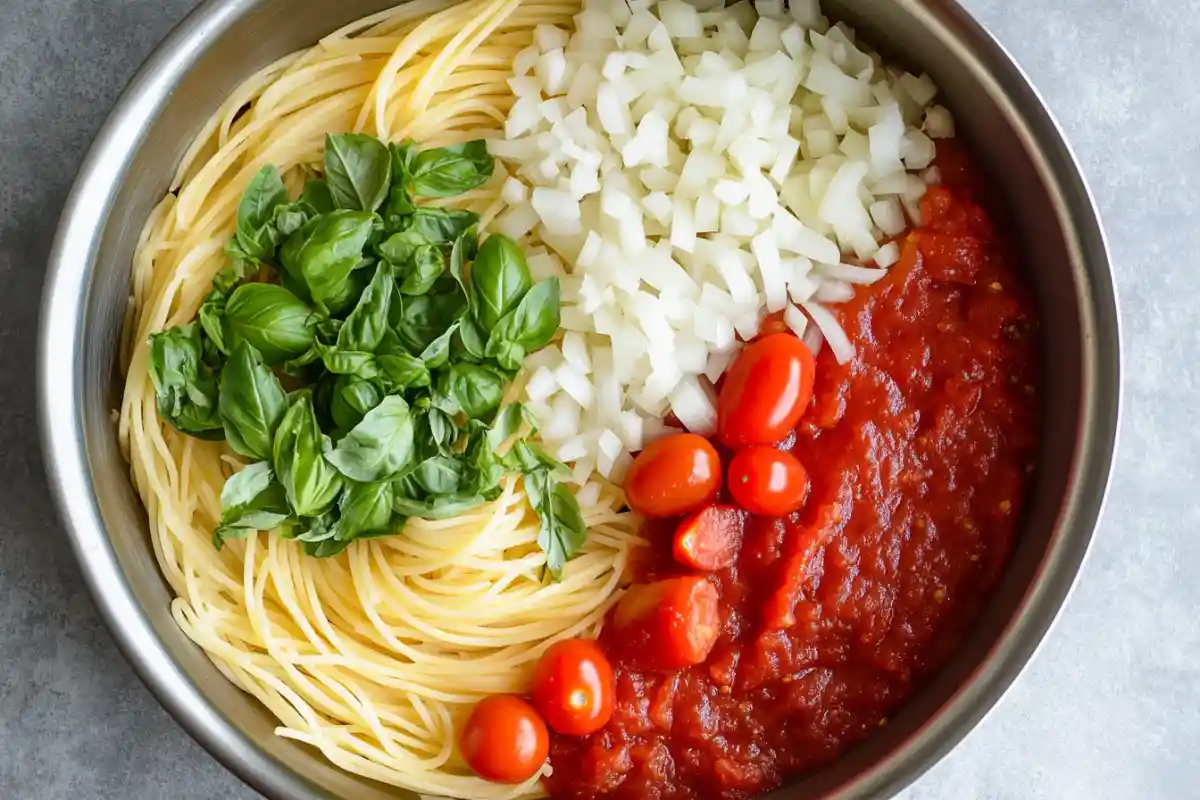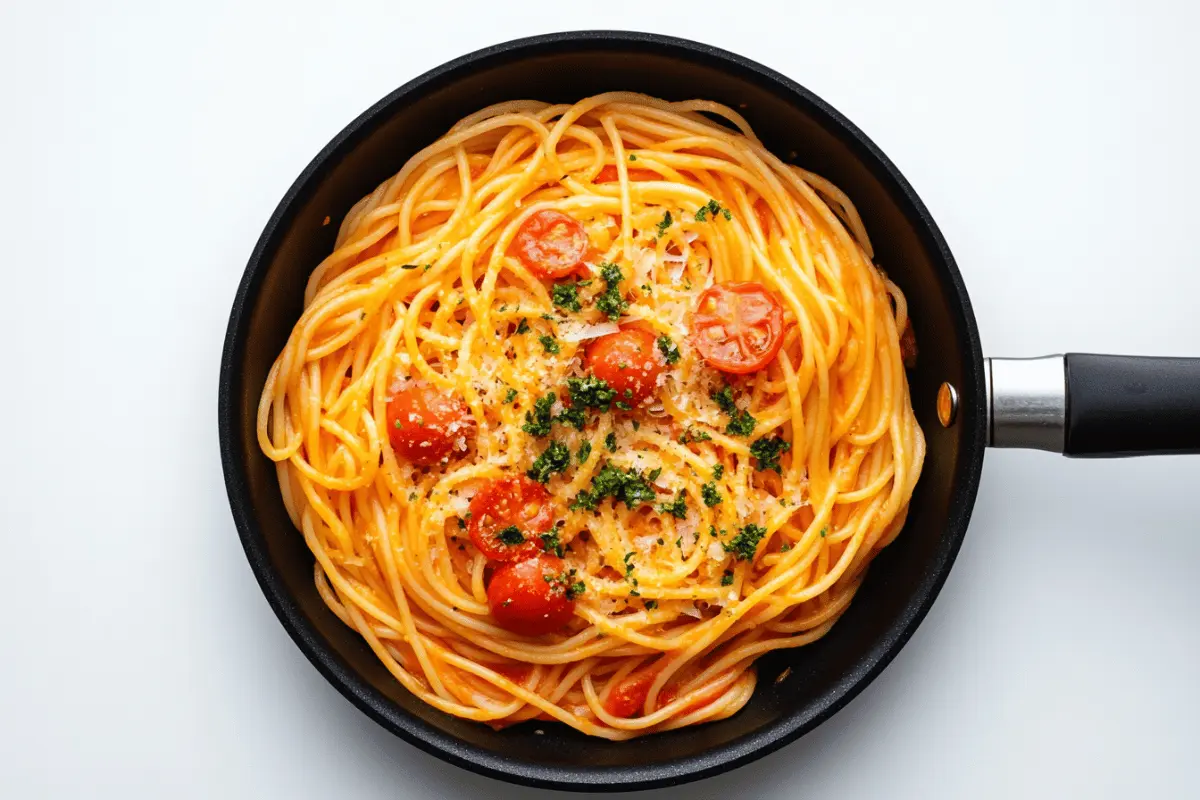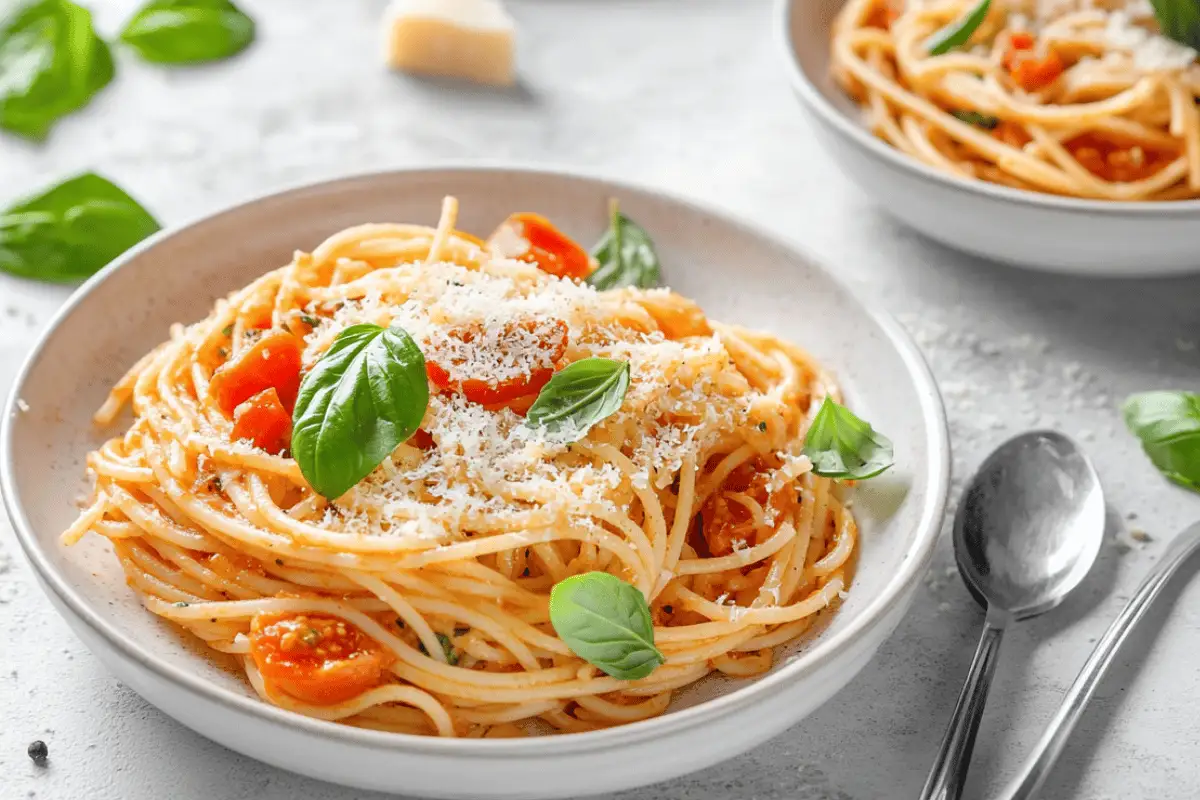Overview
One-Pan Pasta is not only a quick but also an easy dish that’s perfect for busy weeknights or whenever you need a simple yet satisfying meal. Specifically, this method involves cooking the pasta and sauce together in one pan, allowing the pasta to absorb all the flavors as it cooks. Consequently, the result is a delicious, creamy dish with minimal cleanup. In this article, we’ll guide you step-by-step through the process of making a classic one-pan pasta, complete with tips, variations, and serving suggestions.
Part 1: Introduction to One-Pan Pasta
One-pan pasta is a modern twist on traditional pasta cooking methods. Instead of boiling the pasta separately and preparing the sauce in another pan, everything is cooked together in one pot. This method not only saves time but also infuses the pasta with the flavors of the sauce, creating a more cohesive and flavorful dish. It’s perfect for those nights when you want a home-cooked meal without spending hours in the kitchen or dealing with a sink full of dishes. The beauty of one-pan pasta lies in its simplicity and versatility. You can use a variety of ingredients, from fresh vegetables to different types of protein, making it easy to customize based on what you have on hand. Plus, with just one pan, cleanup is a breeze.
Part 2: Ingredients for One-Pan Pasta
To make a delicious one-pan pasta, you’ll need a few basic ingredients. Here’s a simple version that you can customize:

Main Ingredients
- Pasta: Use any pasta you like, but spaghetti or linguine works particularly well for this recipe.
- Garlic: Freshly minced garlic adds a robust flavor to the dish.
- Cherry Tomatoes: Cherry or grape tomatoes add sweetness and color.
- Onions: Thinly sliced onions provide a mild sweetness.
- Basil: Fresh basil adds a burst of herbaceous flavor.
- Olive Oil: A good quality extra virgin olive oil is essential for flavor.
- Vegetable Broth or Water: The liquid that will cook the pasta and create the sauce. You can use water, but vegetable or chicken broth will add more depth of flavor.
- Salt and Pepper: For seasoning.
Optional Add-Ins
- Parmesan Cheese: Grated Parmesan adds a nutty, salty flavor and creaminess to the dish.
- Red Pepper Flakes: For a bit of heat.
- Spinach: Add a handful of fresh spinach for extra nutrients.
- Protein: You can add cooked chicken, shrimp, or sausage to make the dish more filling.
These ingredients are simple yet create a flavorful, balanced meal that’s sure to satisfy.
Part 3: Step-by-Step Guide to Making One-Pan Pasta
Here’s how to make a classic one-pan pasta in just a few easy steps:
Preparation and Cooking Steps
Here’s the revised text with additional transition words for better flow:
- Prepare Your Ingredients: First, start by mincing the garlic, slicing the onions, and halving the cherry tomatoes. Additionally, if you’re adding any protein, ensure it’s cooked and set aside for later use.
- Combine Everything in the Pan: Next, in a large skillet or sauté pan, add the pasta, garlic, onions, tomatoes, basil, olive oil, and a generous pinch of salt and pepper. Afterward, pour in enough vegetable broth or water to just cover the pasta
- Cook the Pasta: Place the pan over medium-high heat and bring the liquid to a boil. Reduce the heat slightly and let it simmer, stirring occasionally to ensure the pasta cooks evenly. As the pasta cooks, it will absorb the liquid, creating a rich sauce. This should take about 10-12 minutes.
- Adjust Seasoning and Finish: Once the pasta is al dente and the liquid has mostly evaporated, taste the dish and adjust the seasoning as needed. Stir in any add-ins like spinach or Parmesan cheese at this stage.
- Serve and Enjoy: Serve the pasta hot, garnished with extra basil or Parmesan if desired. This dish is best enjoyed fresh but can also be stored in the refrigerator for a quick lunch the next day.
This method results in a delicious, comforting meal with minimal effort and cleanup.

Part 4: Variations and Tips for the Perfect One-Pan Pasta
One-pan pasta is incredibly versatile, and there are countless ways to customize it to your liking. To give you some inspiration, here are a few ideas:
Recipe Variations
- Mediterranean-Inspired: For a Mediterranean twist, consider adding olives, artichoke hearts, and feta cheese. These ingredients will infuse your dish with vibrant flavors.
- Creamy Version: If you prefer a richer sauce, stir in a splash of heavy cream or a dollop of cream cheese toward the end of cooking. This addition will give your pasta a luscious, creamy texture.
- Protein-Packed: To make the meal more filling, you can also add grilled chicken, shrimp, or sausage. These proteins will not only enhance the dish but also make it more satisfying.
Vegetarian Delight: For a veggie-packed version, load up on vegetables like zucchini, bell peppers, and mushrooms. This option is perfect for those looking to enjoy a wholesome, plant-based meal.
Tips for Success
- Use a Large Pan: Make sure your pan is large enough to allow the pasta to cook evenly and absorb the liquid.
- Stir Frequently: Stirring helps the pasta cook evenly and prevents it from sticking together or to the bottom of the pan.
- Adjust Liquid as Needed: If the pasta is not fully cooked but the liquid has evaporated, add a little more broth or water, a bit at a time, until the pasta is done.
By experimenting with these variations and tips, you can create a one-pan pasta that suits your taste and dietary needs.
Part 5: Health and Nutritional Information
One-pan pasta can be a nutritious meal, especially when loaded with vegetables and cooked in a flavorful broth. Here’s why it’s a healthy choice:
Nutritional Benefits
- Balanced Meal: This dish offers a good balance of carbohydrates and healthy fats, and when you add protein, it turns into a complete meal.Rich in Vegetables: Adding a variety of vegetables not only enhances the flavor but also boosts the fiber, vitamins, and minerals in the dish.
Low in Cleanup: An often overlooked benefit is that when the cooking process is easy and cleanup is minimal, you’re more inclined to cook at home. This allows you to better control the ingredients and portion sizes.
Healthier Modifications
- Whole Grain Pasta: When choosing your pasta, opt for whole grain or legume-based varieties, as they not only add fiber but also provide a boost of protein, enhancing the nutritional value of your dish.
- Low-Sodium Broth: If you’re planning to use broth, it’s advisable to select a low-sodium version. This choice helps in keeping the salt content in check, contributing to a healthier meal overall.
- Vegetable-Packed: Additionally, the more vegetables you incorporate into your meal, the more nutrient-dense it becomes. By doing so, you’re ensuring that your dish is as wholesome and balanced as possible.
With a few simple tweaks, one-pan pasta can be a part of a healthy, balanced diet.

Part 6: Frequently Asked Questions (FAQs)
Can I use other types of pasta for this recipe?
Yes, you can use any type of pasta, but adjust the cooking time and liquid amount as needed.
Do I have to use broth, or can I use water?
Broth adds more flavor, but you can use water if you prefer. If using water, consider adding extra seasonings.
Can I make this dish vegan?
Absolutely! Use vegetable broth, omit the cheese, and add your favorite plant-based protein.
What if my pasta isn’t cooked through?
If the pasta isn’t fully cooked and the liquid has evaporated, simply add more liquid, a little at a time, until the pasta is tender.
Part 7: Storing and Reheating Leftovers
Leftovers from your one-pan pasta can be a lifesaver on busy days. Proper storage is key to keeping the dish fresh and tasty. Once your pasta has cooled, transfer it to an airtight container. This will help prevent it from drying out in the fridge. Store the pasta in the refrigerator for up to three days.
When you’re ready to reheat, you have a couple of options. The microwave is the quickest method. Place the pasta in a microwave-safe dish, cover it loosely with a lid or microwave-safe wrap, and heat on medium power. Stir halfway through to ensure even heating. If you prefer, you can also reheat the pasta on the stove. Add a splash of water or broth to a pan, then warm the pasta over low heat. Stir occasionally until it’s heated through.
Properly stored and reheated, your one-pan pasta can be just as delicious the next day. This makes it perfect for meal prepping or saving time during the week.
Part 8: Conclusion
One-pan pasta is not only a simple but also a delicious and versatile dish that’s perfect for any night of the week. With minimal ingredients and effort, you can effortlessly create a flavorful meal that’s sure to please everyone at the table. Whether you decide to stick to the classic recipe or choose to experiment with different ingredients, one-pan pasta is undoubtedly a dish you’ll want to make again and again.
